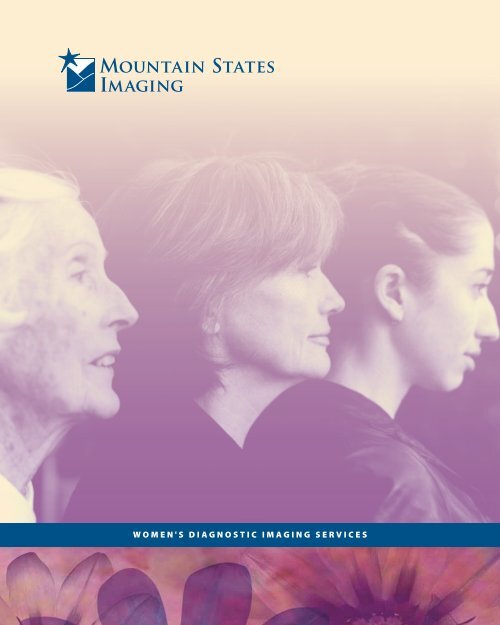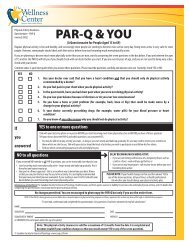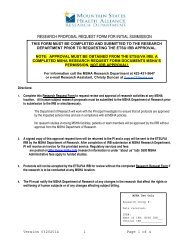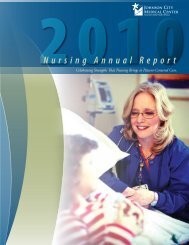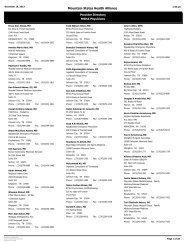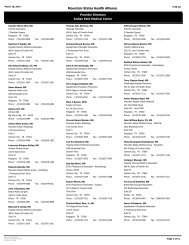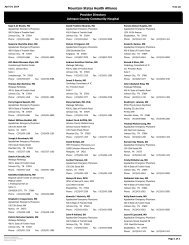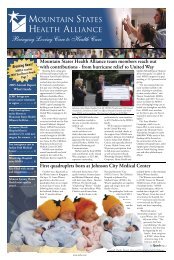women's diagnostic imaging services - Mountain States Health ...
women's diagnostic imaging services - Mountain States Health ...
women's diagnostic imaging services - Mountain States Health ...
Create successful ePaper yourself
Turn your PDF publications into a flip-book with our unique Google optimized e-Paper software.
Women's Imaging ServicesDiagnostic <strong>imaging</strong> is playing a more vital role in the health care needs of women.<strong>Mountain</strong> <strong>States</strong> <strong>Health</strong> Alliance offers a range of testing and <strong>diagnostic</strong> <strong>services</strong>for women in convenient and private settings. Our state-of-the-art <strong>diagnostic</strong>equipment and highly trained and caring staff assist radiologists in obtaining<strong>diagnostic</strong> information that will enable your personal physician to make decisionsregarding your care. Our <strong>diagnostic</strong> facilities for women include:Tennessee Imaging Facilities• Indian Path Medical Center• Johnson County Community Hospital• Sycamore Shoals Hospital• Women’s <strong>Health</strong> and Imaging CenterVirginia Imaging Facilities• Dickenson Community Hospital• Johnston Memorial Hospital• Johnston Memorial Hospital, Women’s Center• Norton Community Hospital• Russell County Medical Center• Smyth County Community Hospitalwww.msha.com/<strong>imaging</strong> | page 3
Digital MammographyDigital (computerized) mammography is similar to standard mammographyin that X-rays are used to produce detailed images of the breast. Digitalmammography uses essentially the same mammography system as conventionalmammography, but the system is equipped with a digital receptor and acomputer instead of a film cassette.Conventional MammogramDigital MammogramFrom the patient’s perspective, a digital mammogram is the same as astandard film-based mammogram in that breast compression and radiationare necessary to create clear images of the breast. The time needed toposition the patient is the same for each method. However, conventionalfilm mammography requires several minutes to develop the film whiledigital mammography provides the image on the computer monitorin less than a minute after the exposure/data acquisition. Thus, digitalmammography provides a shorter exam for the woman and may allowmammography facilities to conduct more mammograms in a day.Digital MammogramDigital mammography can also be manipulated to correct for under- orover-exposure after the exam is completed to help the radiologist moreclearly see certain areas of the breast. The technologist can review the imagejust seconds after the exposure, thus decreasing procedure time.Computer-Aided Detection (CAD)Computer-aided detection (CAD) systems use a digitized mammographicimage that can be obtained from either a conventional film mammogram ora digital mammogram. The computer software then searches for abnormalareas of density, mass or calcification that may indicate the presence ofcancer. The CAD system highlights these areas on the images, alerting theradiologist to the need for further analysis.Computer-Aided Detection(CAD)www.msha.com/<strong>imaging</strong> | page 5
Osteoporosis & Bone Density TestingThe Silent DiseaseOsteoporosis and related bone disorders affect 27 million American women,75 percent of whom don’t even know they have it. While some bone loss canbe expected as part of the normal aging process, osteoporosis is a dangerousdisease. It occurs when bones become porous, brittle and likely to break. Halfof women past menopause have or are at high risk of developing osteoporosis.The good news is that testing is quick, easy and painless, and there are manydifferent treatments available that can reduce the risk of fractures.Bone DensitometryBone densitometry measures the density of bone material to determine ifthere is an increased risk of fracture or osteoporosis. The bone densitometeruses small amounts of X-rays to measure the amount of bone material inthe spine, hip or whole body. Test results will be compared to that of ayoung person, when bone is at its strongest, and to the bone density ofpeople your own age. This gives the physician a basis to determine if youare at risk of osteoporosis fractures. There are several ways to reduce yourchance of fractures, and your physician can discuss these with you.Are You At Risk?Your chances of developing osteoporosis are greater if you are female andanswer “yes” to any of the following questions:Ultrasound of the BreastAre you:• Light-skinned• Thin or small framed• Approaching or past menopause• Milk intolerant or have a low calcium intake• A cigarette smoker or drink alcohol in excess• Taking thyroid medication or steroid-based drugsfor asthma, arthritis or cancerDo you have:• A family history of osteoporosis• Chronic intestinal disorders• A sedentary lifestyleFor More InformationFor more information about osteoporosis, treatment options and bone testing, askyour physician or call the National Osteoporosis Foundation at 1-800-231-4222.www.msha.com/<strong>imaging</strong> | page 9
For Good <strong>Health</strong> & Peace of Mind - Q&AThe American Cancer Society recommends a monthly breast self-exam for womenage 20 and older. It’s important to continue breast self-exams (BSEs) throughout yourlife, even during pregnancy, after menopause, or following any type of breast surgeryor implants.Why Should I Examine My Breasts?A woman knows best how her breasts normally look andfeel and is therefore able to detect changes early. Themajority of lumps that can be felt are found by womenthemselves. This exam takes only a few minutes eachmonth, and can help save your life by finding breastcancer early, when it is most curable.When is the Best Time for Me toExamine My Breasts?Breast self-exams should be performed once a month,5-7 days after your menstrual period ends. This allows awoman to examine her breasts when they are least tenderor swollen. If you have reached menopause, have had ahysterectomy or are pregnant, choose a day that is easyto remember and do a self-exam on that day monthlythereafter. If you are taking birth control pills, performthe exam the first day of your new packet.What Should I Do If I Find a Lump or OtherChange In My Breast?Call your personal physician for an evaluation andmedical opinion. Remember: Most breast lumps areharmless, but all need medical evaluation. Have yourself-exam technique checked by your physician at thetime of your regular check-up. If your doctor does notexamine your breasts during a routine physical, ask forthis to be done. Also, ask your physician to point outareas that may require special attention during yourmonthly self-exam. Although breast cancer cannot beprevented, survival is better when it is detected early andproperly treated. Let monthly breast self-exams becomea habit.When Do I Need a Mammogram?Many women have regular pap smears and checkups yetare unaware they may need a mammogram. According tothe American Cancer Society, women age 40 and oldershould get an annual screening mammogram even if theyappear to show no breast symptoms. This is a generalguideline. Your doctor may advise a different scheduledepending on your personal or family health history.Most women who get breast cancer have no risk factorsexcept age. As a woman gets older, her risk increases.Women who may have an increased risk:• Have a sister, mother or daughter who has had breastcancer.• Have had previous breast cancer.• Have never had children or have their first child afterage 30.• Began menstruating at an early age or went throughmenopause late.page 10 | www.msha.com/<strong>imaging</strong>
Breast Self-ExaminationWhile Lying Down• To examine the right breast,place your right arm overyour head (this distributesbreast tissue evenly). Placea folded towel or pillowbeneath the shoulder.• With your left hand, use theflat part of your fingers to press gently but firmlyin small circular motions around entire breast andinward toward the nipple.• Many women feel a firm ridge of tissue underneaththeir breasts. This is usually normal and commonlyfeels the same on both sides. Some women havenaturally lumpy breasts and should record the areasof thickening.• Examine the area between the breast and armpit, aswell as the armpit itself.• Depress your nipple. Normally the area behind thenipple feels hollow and soft. This area should feelsimilar in both breasts.• Repeat this procedure on your left breast, usingyour right hand.In the Tub or Shower• Continue to use the samecircular motions. The soap andwater will allow your handsto glide more smoothly overyour skin. Check for lumps orunusual thickenings.• With the right arm raised, use the flat pads of yourfingers from your left hand and reach up highand deep. Feel the area between the breast andthe armpit, as well as the armpit itself. Repeat onopposite side.• Check the area above and below your collarbone forthickness, lumps and swelling.In Front of a MirrorIn good light, turn side toside in these positions:1. Relax arms at sides.2. Place hands on hipsand press down on hipbones.3. Clasp hands behindhead with elbows pulledback.4. Place hands on waistand bend forward sobreasts hang.In each position, look for:• Nipple change (inverted, flattened, crustyappearance)• Nipple discharge• Puckering or dimpling• Change in breast shape, contour or size• Scaling, redness, rash, sores or unusual texture• Anything that is unusual or causes you concernFor the Mastectomy PatientContinue monthly self-exams for the remaining breast.Look in the mirror for redness, scaliness or rash. Payparticular attention to the scar line. Feel betweeneach rib and over the breast bone for thickness, lumpsand swelling. Remember to feel under both arms andabove and below collarbones.www.msha.com/<strong>imaging</strong> | page 11
Tennessee Imaging Facilities• Indian Path Medical Center• Johnson County Community Hospital• Sycamore Shoals Hospital• Women’s <strong>Health</strong> and Imaging CenterVirginia Imaging Facilities• Dickenson Community Hospital• Johnston Memorial Hospital• Johnston Memorial Hospital, Women’s Center• Norton Community Hospital• Russell County Medical Center• Smyth County Community Hospitalmountain states health allianceBringing Loving Care to <strong>Health</strong> Care<strong>women's</strong> <strong>diagnostic</strong> <strong>imaging</strong> <strong>services</strong>DI-00081 > REV. 07/2012


